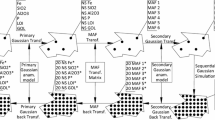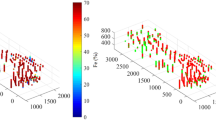Abstract
Many of the open-pit mines suffer from the lack of reconciliation between estimated and actual grades. In a mining operation, grade reconciliation is the comparison between the values of the estimated grade calculated in exploration stage and the actual grade obtained from more reliable data such as blast holes’ samples. Many different factors affect the degree of reconciliation in a mining operation. In this paper, the factors related to estimated grade which affect the reconciliation process in the exploration stage of the orebody are investigated. These factors constitute the sources of uncertainty for the upcoming phases of the mining life. Among these parameters, the inherent variability, statistical uncertainty, and systematic uncertainty are the most important factors. In this work, these parameters are studied in further detail, and, accordingly, for each of these uncertainties, a correction factor is determined in the proposed model. The model was applied to the study of real data taken from an iron open-pit mine in Iran. The results of the case study indicated that the systematic uncertainty, inherent variability, and statistical uncertainty are, in order, the main sources of uncertainty on grade reconciliation process. Applying the correction factors to estimated grade values has increased the amount of grade reconciliation from 10%, at original condition, to 50%, at new condition, in the case study.










Similar content being viewed by others
References
Ang AH-S, Tang WH (1984) Probability concepts in engineering planning and design, vol 2. Wiley, New York, pp 333–400
Baker CT, Giacomo SM (1998) Resource and Reserve: their uses and abuses by the equity markets. Ore reserve and Finance: A Joint Seminar between Australasian Institute of Mining and Metallurgy and ASX, Sydney
Burmeister B (1988) From resource to reality: a critical review of the achievements of new Australian gold mining projects during the period January 1983 to September 1987, Macquarie University
Carrasco P, Carrasco P, Jara E (2004) The economic impact of correct sampling and analysis practices in the copper mining industry. Chemometrics Intelligent Lab Syst J 74:209–213
Clow G (1991) Why gold mines fail. North Min Mag 2(4):31–34
Crawford D (2003) Reconciliation of reserves. (Part 1), Pincock Perspectives, Colorado, ISSUE No. 49–December 2003
Dimitrakopoulos R, Martinez L, Ramazan S (2007) A maximum upside/minimum downside approach to the traditional optimization of open pit mine design. J Mining Sci 43(1):73–82
Duzgun HSB, Yucemen MS, Kapruz C (2002) A probabilistic model for the assessment of uncertainties in the shear strength of rock discontinuities. Int J Rock Mech Min Sci 39:743–754
Elliot MS, Snowden V, Bywater A et al (2001) Reconciliation of the McKinnons gold deposit, Cobar, New South Wales. The Australasian Institute of Mining and Metallurgy, Melbourne
Haren E, Williams P (2000) Mine geology practices at the Sunrise open pit. 4th International Mining Geology Conference, Coolum, Queensland, 14–17 May 2000
Knoll K (1989) And now the bad news. North Min Mag 4(6):48–52
Magri E, Ortiz J (2000) Estimation of economic losses due to poor blast hole sampling in open pits. WJ Kleingeld and Krige (eds), Geostats 2000, Cape Town, Document transformation technologies, Printed in South Africa
Morley C (2003) Beyond reconciliation–a proactive approach to using mining data. Fifth Large Open Pit Mining Conference, Kalgoorlie, WA, 3–5 November
Noppe M (2004) Reconciliation: importance of good sampling and data QA-QC. Mining and Resource Geology Symposium, XYZ, EGRU Contribution No.62
Rossi M, Parker HM (1993) Estimating recoverable reserves–is it hopeless? Geostatistics for the next century, Montreal, Quebec, Canada, June 3–5
Schofield NA (2001) The myth of mine reconciliation. In: Mineral resource and ore reserve estimation—the AusIMM Guide to Good Practice (Ed A C Edwards), pp. 601–610, The Australasian Institute of Mining and Metallurgy: Melbourne
Snowden V (2000) Grade control and reconciliation. Snowden Associates Pty Ltd, West Perth
Thomas M, Snowden V (1990) Improving reconciliation and grade control by statistical and geostatistical analysis. Strateg grade control. AIG Bull 10:49–59
Vallee M (2000) Mineral resource+engineering, economic and legal feasibility = ore reserve. CIM Bull 93(1039):53–61
Warren M (1991) Pre-feasibility and feasibility studies: a case for improvements. In Minopt 91. The Australasian Institute of Mining and Metallurgy, Melbourne
Author information
Authors and Affiliations
Corresponding author
Rights and permissions
About this article
Cite this article
Parhizkar, A., Ataei, M., Moarefvand, P. et al. A probabilistic model to improve reconciliation of estimated and actual grade in open-pit mining. Arab J Geosci 5, 1279–1288 (2012). https://doi.org/10.1007/s12517-010-0275-2
Received:
Accepted:
Published:
Issue Date:
DOI: https://doi.org/10.1007/s12517-010-0275-2




